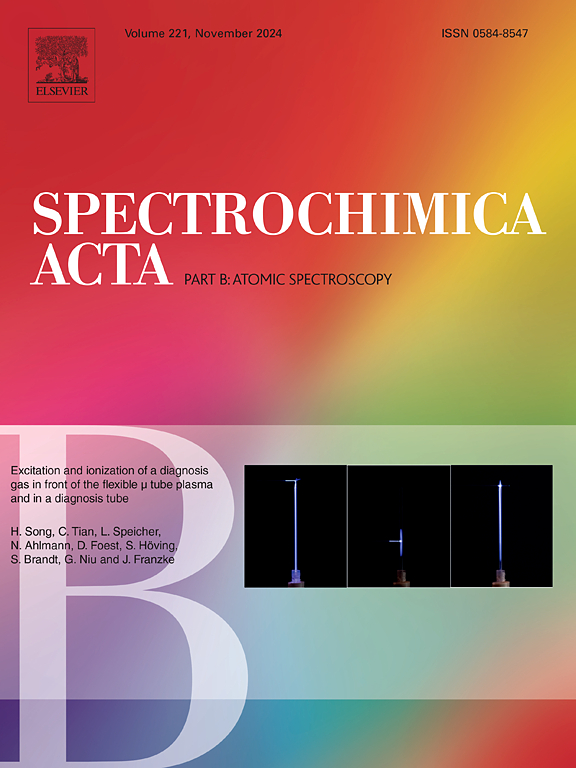High-resolution spectroscopy of uranium laser-produced plasma using saturated absorption spectroscopy
IF 3.2
2区 化学
Q1 SPECTROSCOPY
引用次数: 0
Abstract
High-resolution spectroscopy of laser ablation plumes or laser-produced plasmas (LPPs) is valuable for various applications, including measuring crowded spectral features, determining spectroscopic constants, characterizing plasmas, and performing isotopic analysis. However, various line broadening mechanisms in plasmas limit its use for several applications. Here, we present the use of saturated absorption spectroscopy (SAS) for Doppler-free linewidth analysis in a uranium LPP. We demonstrate that SAS is effective in obtaining Doppler-free Lamb dip profiles with linewidths on the order of ≤ 20 MHz. The effects of saturation on the Doppler-broadened absorption and Lamb dip profiles at different pressures and probe intensities are quantified, and their impact on measurements of plasma properties is discussed. Finally, we show that the linewidths of the Lamb dips can be used for quantitative estimates of pressure and natural broadening in the plasma.

求助全文
约1分钟内获得全文
求助全文
来源期刊
CiteScore
6.10
自引率
12.10%
发文量
173
审稿时长
81 days
期刊介绍:
Spectrochimica Acta Part B: Atomic Spectroscopy, is intended for the rapid publication of both original work and reviews in the following fields:
Atomic Emission (AES), Atomic Absorption (AAS) and Atomic Fluorescence (AFS) spectroscopy;
Mass Spectrometry (MS) for inorganic analysis covering Spark Source (SS-MS), Inductively Coupled Plasma (ICP-MS), Glow Discharge (GD-MS), and Secondary Ion Mass Spectrometry (SIMS).
Laser induced atomic spectroscopy for inorganic analysis, including non-linear optical laser spectroscopy, covering Laser Enhanced Ionization (LEI), Laser Induced Fluorescence (LIF), Resonance Ionization Spectroscopy (RIS) and Resonance Ionization Mass Spectrometry (RIMS); Laser Induced Breakdown Spectroscopy (LIBS); Cavity Ringdown Spectroscopy (CRDS), Laser Ablation Inductively Coupled Plasma Atomic Emission Spectroscopy (LA-ICP-AES) and Laser Ablation Inductively Coupled Plasma Mass Spectrometry (LA-ICP-MS).
X-ray spectrometry, X-ray Optics and Microanalysis, including X-ray fluorescence spectrometry (XRF) and related techniques, in particular Total-reflection X-ray Fluorescence Spectrometry (TXRF), and Synchrotron Radiation-excited Total reflection XRF (SR-TXRF).
Manuscripts dealing with (i) fundamentals, (ii) methodology development, (iii)instrumentation, and (iv) applications, can be submitted for publication.

 求助内容:
求助内容: 应助结果提醒方式:
应助结果提醒方式:


